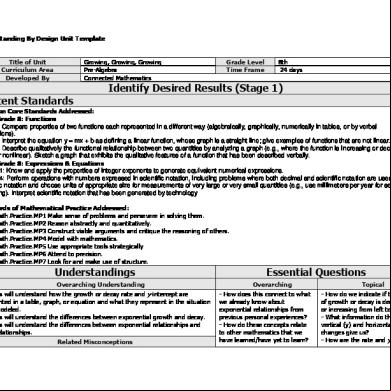Shiitake Mushroom Growing Instructions 5j1en
This document was ed by and they confirmed that they have the permission to share it. If you are author or own the copyright of this book, please report to us by using this report form. Report 2z6p3t
Overview 5o1f4z
& View Shiitake Mushroom Growing Instructions as PDF for free.
More details 6z3438
- Words: 1,502
- Pages: 4
How to Grow Shiitake Mushrooms Epogee Ltd – Suppliers of Mushroom Spawn for small scale production
www.epogee.co.uk/mushrooms VISIT OUR WEBSITE TO PURCHASE A RANGE OF MUSHROOM SPAWN/KITS AT ATTRACTIVE PRICES Instructions and ebooks also available for free . All rights reserved. No copying or distribution without permission. Copyright Epogee Ltd
Storage Instructions: The spawn supplied by Epogee Ltd must be stored in a clean place at 1-5ºC until use (eg refrigerator). Spawn will lose its viability with age, so it is best used sooner rather than later. The spawn needs to breathe, so do not store in a sealed container. Do not allow the mushroom spawn to freeze.
Substrate Preparation Select your substrate. Shiitake mushrooms require cellulose-rich material, and will grow on a variety of substrates woody substrates. My preference is for oak (or other hardwood) sawdust. In fact, Shiitake will grow on softwood sawdust – which is often far easier to obtain – but ideally requires some additional nutrients (growers often add material such as bran, sugar etc to provide this). Also, some growers recommend wetting the sawdust and leaving it for 7days to partially ferment before using for Shiitake growing, although we have never tried this ourselves. Shiitake will probably grow on a variety of other materials, and experimentation will reveal those best suited. Two general methods work for Shiitake growing:
1)Logs Summary: Slow process, lower yields of mushrooms, better taste, less maintenance required, easy to do outdoors and without any specialist equipment. Shiitake naturally grows on hardwood logs. Logs of 100-200mm diameter are best – as they are easiest to handle. The logs should be innoculated within 6 weeks of felling, because it gives the shiitake the greatest chance of colonisation with least threat of competing microorganisms. Ideally, the log should be cut when the tree is dormant, although if trees have fallen over, it makes sense to innoculate regardless of time of year. Logs are often innoculated using shiitake dowels, but actually, spawn can be used just as well. Clean the surface of the log with a wire brush but not hard enough to remove the bark. Bore Holes of 8-10mm diameter, and about 30mm deep into the log at 150mm intervals, spaced evenly over the
entire surface of the log. Fill each hole with substrate and seal the top with hot wax to prevent dirt, microbes etc entering, The heat also sterilises the top layer of spawn, thus killing any potential contaminants on the surface of the spawn. It may be advantageous to partially bury the the grown (horizontally) – this helps to keep the log moist. Locate the a cool shady area, away from direct sunshine. The spawn run will take 5-12months dependant on temperature. The log will tend to fruit twice a year – spring and autumn, although it's possible to force the to fruiting more often by soaking for 24-48 hours in cold water and then standing up in a shading area away from winds (some people prefer to initiate the crop by spraying liberally with a hose). Lay the logs down to rest for 6-8 weeks after fruiting, then repeat the cold shock to initiate the next crop. Logs can fruit for several years before they become exhausted.
2)Artificial Sawdust 'logs' in bags. This is my prefered option – so I will describe this in more detail. It is relatively easy, and much quicker than using natural logs (3months to fruiting). The yield is much higher, but the taste is less 'earthy' and some consider the taste inferior to natural log-grown shiitake. Substrate Preparation Substrate: I have used sawdust on its own successfully, but the yields are likely to be a lot lower than if nutrients are added. A typical recipe might be; Hardwood Sawdust 3-4% Rice Bran 1% Wheat Bran 1% chalk or 75% hardwood sawdust 25% straw 1% chalk Due to its slower growth, Shiitake substrate is best sterilised rather than pasteurised, although not so easy to do at home. However, I have been perfectly successful using a pasteurised substrate. Ideally, the substrate should be heated to 120C for a couple of hours under pressure (1bar) to sterilise. A pressure cooker can be used to easily achieve this. I use an additional vessel (a perforated biscuit tin) in the upper region of the pressure cooker to increase capacity. The strain sold by www.epogee.co.uk is particularly suitable to growing under non-sterile conditions. For example, I have successfully grown shiitake by heating sawdust to 100C for 30minutes and then leaving to cool. Once cooled (NB the sawdust must be cooled to below 30C, otherwise there is the danger of killing the spawn before it's even started growing. Leaving the sawdust to cool overnight without opening the pressure cooker is a good option.
Innoculation Once cooled, the spawn should be thoroughly mixed into the sawdust. The better mixed at this stage, the faster the spawn will colonise the substrate. I have seen good colonisation within 14days where the substrate has been prepared in this manner. I usually mix the substrate/grain by hand, but it does require clean conditions, and there's always a risk of contamination. First I spray the worksurface with antibacterial spray, and wipe down. I do the same to a metal tray which will be used for mixing. Immediately before handling the substrate or spawn, I wash my hand thoroughly and after drying, use an alcohol-foam to sterilise the surface of my hands. I then ensure that the tray is completely dry, and spread the semi-sterilised sawdust onto it. The spawn is added, and it is thoroughly mixed. Any clumps of spawn are broken into their component parts. The more innoculation points the better – it's the number of particles rather than the total mass which will ensure a fast colonisation. Once the substrate/spawn have been thoroughly and evenly mixed, it should be loaded into a clean (preferably sterile) plastic bag. The bag can be loosely tied, or you can use a collar ring and some cotton wool to provide gas-exchange. In these pictures I have used plastic tubing designed for heatsealing, which is ideal, but a clean carrier bag or packaging bag could easily be substituted. Stages of Growth Growing Shiitake on sawdust consists of 5 stages: 1)Spawn Run & Coat formation DURATION: 1-3months TEMPERATURE: 20-30C LIGHT: NONE NECESSARY HUMIDITY: 65-70% This can take 1-3months depending on the type of substrate, temperature, humidity and the way it has been prepared. The spawn run should be allowed to take place in a warm environment (eg room temperature) . It may be necessary to add clean water from time to time to keep the substrate moist (but not too wet). As the spawn run nears completion, a white coat will begin to form on the outside of the substrate mass. This coat will help to prevent infection. This will begin 24weeks after innoculation. The surface will eventually begin to develop bumps. These bumps may go on to turn into primordia (which eventually turn into mushrooms), but many will abort. Once bumps start to form, increase the aeration (by slitting bag and/or increasing ventilation) which will allow some red/brown colouration to form on the surface. 2)Coat hardening ('Browning') Remove the plastic bag altogether when approximately 1/3 of the substrate has turned brown. Maintain humidity etc as for previous stage, spraying as necessary to compensate for the additional aeration. The purpose of this stage is to increase oxygen levels at the surface to ripen it.
3)Shocking DURATION: 2days TEMPERATURE: 10-20C LIGHT: DAYLIGHT LEVELS (500-1000lux) HUMIDITY: 85-95% Shiitake can be shocked by a variety of methods. Physical shock is one trigger. Another is immersion in a cold water bath for 48hours. At the same time, daylight levels of lighting should be present. 4)Fruiting DURATION: 7-14days TEMPERATURE: 12-18C LIGHT: DAYLIGHT LEVELS (500-1000lux) HUMIDITY: 60-80% When the mushrooms fruit, cut the mushroom close to the surface. Do not tear out of the block, or damage leading to infection can occur. Once the block has fruited, move to the recovery phase. 5)Recovery DURATION: 7-21days TEMPERATURE: 20-30C LIGHT: DAYLIGHT LEVELS none necessary HUMIDITY: 65-70% Lower the humidity and increase the temperature during the recovery phase to allow the blocks to heal. At the end of this stage, proceed to the Shock phase, which re-initiates fruiting, but also, importantly, replemishes the water stored in the block, which will be necessary for the production of new mushrooms. Blocks will fruit approximately 6 times. Towards the end, mushrooms will be smaller and will produce lower yields. SUPPLIES For low cost mushroom spawn in small or large quantities, please visit www.epogee.co.uk/mushrooms
Safety Warning Take care when pouring hot water to avoid scalds. Avoid inhaling dust created by the substrate or spores from fruiting mushrooms. Dusty substrates will be much safer to handle when damp. Harvest mushrooms before spores are deposited Only pick and eat shiitake mushrooms. If the substrate is not properly pasteurised, it is just possible that other types of mushrooms may develop, which may not be edible.
www.epogee.co.uk/mushrooms VISIT OUR WEBSITE TO PURCHASE A RANGE OF MUSHROOM SPAWN/KITS AT ATTRACTIVE PRICES Instructions and ebooks also available for free . All rights reserved. No copying or distribution without permission. Copyright Epogee Ltd
Storage Instructions: The spawn supplied by Epogee Ltd must be stored in a clean place at 1-5ºC until use (eg refrigerator). Spawn will lose its viability with age, so it is best used sooner rather than later. The spawn needs to breathe, so do not store in a sealed container. Do not allow the mushroom spawn to freeze.
Substrate Preparation Select your substrate. Shiitake mushrooms require cellulose-rich material, and will grow on a variety of substrates woody substrates. My preference is for oak (or other hardwood) sawdust. In fact, Shiitake will grow on softwood sawdust – which is often far easier to obtain – but ideally requires some additional nutrients (growers often add material such as bran, sugar etc to provide this). Also, some growers recommend wetting the sawdust and leaving it for 7days to partially ferment before using for Shiitake growing, although we have never tried this ourselves. Shiitake will probably grow on a variety of other materials, and experimentation will reveal those best suited. Two general methods work for Shiitake growing:
1)Logs Summary: Slow process, lower yields of mushrooms, better taste, less maintenance required, easy to do outdoors and without any specialist equipment. Shiitake naturally grows on hardwood logs. Logs of 100-200mm diameter are best – as they are easiest to handle. The logs should be innoculated within 6 weeks of felling, because it gives the shiitake the greatest chance of colonisation with least threat of competing microorganisms. Ideally, the log should be cut when the tree is dormant, although if trees have fallen over, it makes sense to innoculate regardless of time of year. Logs are often innoculated using shiitake dowels, but actually, spawn can be used just as well. Clean the surface of the log with a wire brush but not hard enough to remove the bark. Bore Holes of 8-10mm diameter, and about 30mm deep into the log at 150mm intervals, spaced evenly over the
entire surface of the log. Fill each hole with substrate and seal the top with hot wax to prevent dirt, microbes etc entering, The heat also sterilises the top layer of spawn, thus killing any potential contaminants on the surface of the spawn. It may be advantageous to partially bury the the grown (horizontally) – this helps to keep the log moist. Locate the a cool shady area, away from direct sunshine. The spawn run will take 5-12months dependant on temperature. The log will tend to fruit twice a year – spring and autumn, although it's possible to force the to fruiting more often by soaking for 24-48 hours in cold water and then standing up in a shading area away from winds (some people prefer to initiate the crop by spraying liberally with a hose). Lay the logs down to rest for 6-8 weeks after fruiting, then repeat the cold shock to initiate the next crop. Logs can fruit for several years before they become exhausted.
2)Artificial Sawdust 'logs' in bags. This is my prefered option – so I will describe this in more detail. It is relatively easy, and much quicker than using natural logs (3months to fruiting). The yield is much higher, but the taste is less 'earthy' and some consider the taste inferior to natural log-grown shiitake. Substrate Preparation Substrate: I have used sawdust on its own successfully, but the yields are likely to be a lot lower than if nutrients are added. A typical recipe might be; Hardwood Sawdust 3-4% Rice Bran 1% Wheat Bran 1% chalk or 75% hardwood sawdust 25% straw 1% chalk Due to its slower growth, Shiitake substrate is best sterilised rather than pasteurised, although not so easy to do at home. However, I have been perfectly successful using a pasteurised substrate. Ideally, the substrate should be heated to 120C for a couple of hours under pressure (1bar) to sterilise. A pressure cooker can be used to easily achieve this. I use an additional vessel (a perforated biscuit tin) in the upper region of the pressure cooker to increase capacity. The strain sold by www.epogee.co.uk is particularly suitable to growing under non-sterile conditions. For example, I have successfully grown shiitake by heating sawdust to 100C for 30minutes and then leaving to cool. Once cooled (NB the sawdust must be cooled to below 30C, otherwise there is the danger of killing the spawn before it's even started growing. Leaving the sawdust to cool overnight without opening the pressure cooker is a good option.
Innoculation Once cooled, the spawn should be thoroughly mixed into the sawdust. The better mixed at this stage, the faster the spawn will colonise the substrate. I have seen good colonisation within 14days where the substrate has been prepared in this manner. I usually mix the substrate/grain by hand, but it does require clean conditions, and there's always a risk of contamination. First I spray the worksurface with antibacterial spray, and wipe down. I do the same to a metal tray which will be used for mixing. Immediately before handling the substrate or spawn, I wash my hand thoroughly and after drying, use an alcohol-foam to sterilise the surface of my hands. I then ensure that the tray is completely dry, and spread the semi-sterilised sawdust onto it. The spawn is added, and it is thoroughly mixed. Any clumps of spawn are broken into their component parts. The more innoculation points the better – it's the number of particles rather than the total mass which will ensure a fast colonisation. Once the substrate/spawn have been thoroughly and evenly mixed, it should be loaded into a clean (preferably sterile) plastic bag. The bag can be loosely tied, or you can use a collar ring and some cotton wool to provide gas-exchange. In these pictures I have used plastic tubing designed for heatsealing, which is ideal, but a clean carrier bag or packaging bag could easily be substituted. Stages of Growth Growing Shiitake on sawdust consists of 5 stages: 1)Spawn Run & Coat formation DURATION: 1-3months TEMPERATURE: 20-30C LIGHT: NONE NECESSARY HUMIDITY: 65-70% This can take 1-3months depending on the type of substrate, temperature, humidity and the way it has been prepared. The spawn run should be allowed to take place in a warm environment (eg room temperature) . It may be necessary to add clean water from time to time to keep the substrate moist (but not too wet). As the spawn run nears completion, a white coat will begin to form on the outside of the substrate mass. This coat will help to prevent infection. This will begin 24weeks after innoculation. The surface will eventually begin to develop bumps. These bumps may go on to turn into primordia (which eventually turn into mushrooms), but many will abort. Once bumps start to form, increase the aeration (by slitting bag and/or increasing ventilation) which will allow some red/brown colouration to form on the surface. 2)Coat hardening ('Browning') Remove the plastic bag altogether when approximately 1/3 of the substrate has turned brown. Maintain humidity etc as for previous stage, spraying as necessary to compensate for the additional aeration. The purpose of this stage is to increase oxygen levels at the surface to ripen it.
3)Shocking DURATION: 2days TEMPERATURE: 10-20C LIGHT: DAYLIGHT LEVELS (500-1000lux) HUMIDITY: 85-95% Shiitake can be shocked by a variety of methods. Physical shock is one trigger. Another is immersion in a cold water bath for 48hours. At the same time, daylight levels of lighting should be present. 4)Fruiting DURATION: 7-14days TEMPERATURE: 12-18C LIGHT: DAYLIGHT LEVELS (500-1000lux) HUMIDITY: 60-80% When the mushrooms fruit, cut the mushroom close to the surface. Do not tear out of the block, or damage leading to infection can occur. Once the block has fruited, move to the recovery phase. 5)Recovery DURATION: 7-21days TEMPERATURE: 20-30C LIGHT: DAYLIGHT LEVELS none necessary HUMIDITY: 65-70% Lower the humidity and increase the temperature during the recovery phase to allow the blocks to heal. At the end of this stage, proceed to the Shock phase, which re-initiates fruiting, but also, importantly, replemishes the water stored in the block, which will be necessary for the production of new mushrooms. Blocks will fruit approximately 6 times. Towards the end, mushrooms will be smaller and will produce lower yields. SUPPLIES For low cost mushroom spawn in small or large quantities, please visit www.epogee.co.uk/mushrooms
Safety Warning Take care when pouring hot water to avoid scalds. Avoid inhaling dust created by the substrate or spores from fruiting mushrooms. Dusty substrates will be much safer to handle when damp. Harvest mushrooms before spores are deposited Only pick and eat shiitake mushrooms. If the substrate is not properly pasteurised, it is just possible that other types of mushrooms may develop, which may not be edible.











